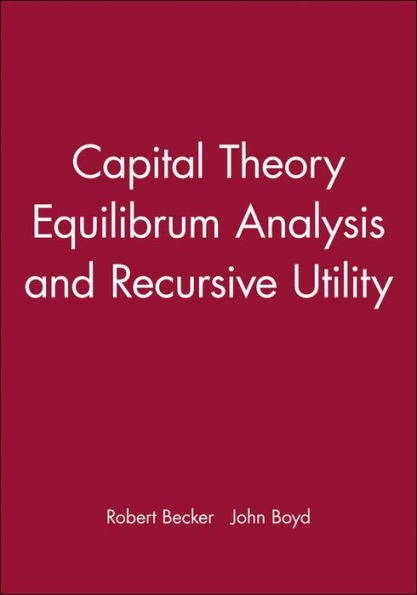Capital Theory Equilibrum Analysis and Recursive Utility / Edition 1 available in Hardcover

Capital Theory Equilibrum Analysis and Recursive Utility / Edition 1
- ISBN-10:
- 1557864136
- ISBN-13:
- 9781557864130
- Pub. Date:
- 07/07/1997
- Publisher:
- Wiley

Capital Theory Equilibrum Analysis and Recursive Utility / Edition 1
Hardcover
Buy New
$143.75Overview

Product Details
| ISBN-13: | 9781557864130 |
|---|---|
| Publisher: | Wiley |
| Publication date: | 07/07/1997 |
| Pages: | 368 |
| Product dimensions: | 6.30(w) x 9.33(h) x 1.29(d) |
About the Author
Table of Contents
List of Examples.Preface.
Part I: The Recursive Utility Approach:.
1. Introduction.
2. What is a Recursive Utility Function?.
3. Why Study Recursive Utility?.
3.1. The Long Run Incidence of Capital Taxation. The Tax Model. Tax Incidence with the TAS Specification. Tax Incidence With the Epstein-Hynes Utility Specification.
3.2. The Impatience Problem. The Impatience Problem with an Epstein-Hynes Utility Function.
4. Recursive Utility and Commodity Spaces.
4.1 Diminishing Returns and Bounded Growth.
4.2 Nondecreasing Returns and Sustained Growth. Growth and Exogenous Technical Progress. Endogenous Growth Models.
4.3. Order Structures. Weak Separability of the Future from the Present. Partial Orders on the Commodity Space.
5. Conclusion.
Part II: Commodity and Price Spaces:.
1. Introduction.
2. Commodity Spaces.
2.1. Order Properties. Free Disposal.
2.2 Topological Properties. Metric Spaces. Continuity. Compactness, Product Spaces, and the Tychonoff. Theorem. Connectedness.
2.3. Linear Topologies. Order Convergence. Contraction Mapping Theorems.
3. Commodity Price Dualities.
3.1. Duals and Hyperplanes.
3.2. Hahn-Banach Theorems.
3.3. Dual Pairs and Weak Topologies.
3.4. Order Duals.
4. Conclusion.
Part III: Representation of Recursive Preferences:.
1. Introduction.
2. Preference Orders and Utility Theory.
3. Recursive Utility: The Koopmans Axioms.
3.1. The Axioms.
3.2. Biconvergence.
3.3. Recursive Preferences and Myopia.
4. Impatience, Discounting and Myopia.
4.1. Impatience and Time Perspective.
4.2. Myopia and the Continuity Axiom.
4.3. The Norm of Marginal Impatience Conditions.
5. Recursive Utility: The Aggregator.
5.1. Basic Properties of the Aggregator.
5.2. The Existence of Recursive Utility.
5.3. Aggregators Bounded From Below.
5.4. Unbounded Aggregators.
6. Conclusion.
Part IV: Existence and Characterization of Optimal Paths:.
1. Introduction.
2. Fundamentals of Existence Theory.
2.1. A Simple Capital Accumulation Model.
2.2. The Weierstrass Theorem.
2.3. One-Sector TAS Existence Theory.
2.4. Extended Utilitarianism.
3. Multisector Capital Accumulation Model.
3.1. The von Neumann and Malinvaud Models.
3.2. The Feasible Correspondence.
4. The Existence and Sensitivity of Optimal Paths.
4.1. The Maximum Theorem.
4.2. Optimal Paths.
5. Recursive Dynamic Programming.
5.1. Dynamic Programming with TAS Utility.
5.2. Recursive Utility and Multisector Models.
5.3. Dynamic Programming and Extended Utilitarianism.
6. Characterization of Optimal Paths.
6.1. No-Arbitrage Conditions.
6.2. Complete Characterization of Optimal Paths.
7. Conclusion.
Part V:.
1. Introduction.
2. One-Sector Models.
2.1. Stationary States in One-Sector Models.
2.2. Monotonicity and Turnpikes in TAS Models.
2.3. Monotonocity and Turnpikes in Recursive Models.
2.4. Growing Economies.
3. Steady States in Multisectoral Models.
3.1. Stationary Optimal Programs for Additive Utility.
3.2. Stationary Optimal Programs for Recursive Utility.
4. Stability of Multisectoral Models.
4.1. The Undiscounted Model.
4.2. The Visit Lemma.
4.3. Uniqueness of Steady States.
4.4. Local and Global Stability.
5. Cycles and Chaos in Optimal Growth.
5.1. The Existence of Cycles.
5.2. Chaotic Dynamics.
6. Conclusion.
Part VI: Equivalence Principles and Dynamic Equilibria:.
1. Introduction.
2. Equivalence Principles for One-Sector Models.
2.1. The Perfect Foresight Equivalence Theorem. Perfect Foresight Competitive Equilibrium. The PFCE Equivalence Principle.
2.2. The Fisher Equivalence Theorem.
2.3. The Equivalence Theorem and the Transversality Condition.
2.4. Recursive Competitive Equilibrium and Recursive Utility.
3. Multisector Equivalence Principles.
3.1. The Portfolio Equilibrium Condition.
3.2. The Two-Sector Model's Equivalence Theorem. The Household Sector. The Production Sector. The Transformation Function. Perfect Foresight Equilibrium. The Optimal Growth Problem. The Equivalence Theorem.
3.3. Dynamics and The Two-Sector Model's Equivalence Theorem.
4. The Transversality Condition and the Hahn Problem.
5. Conclusion.
Part VII: Comparative Dynamics:.
1. Introduction.
2. The Reduced-Form TAS Model.
2.1. Comparative Dynamics.
2.2. Comparative Dynamics for Oscillating Programs.
2.3. Comparative Dynamics and Capital Income Tax Reform.
3. A Primer of Lattice Programming.
3.1. More About Lattices.
3.2. An Introduction to Monotone Comparative Statistics.
3.3. Topkis's Theorems.
4. Lattice Programming and the Reduced-Form TAS Model.
4.1. The Monotonicity of Optimal Capital Policy Function.
4.2. The Capital Deepening Theorem.
5. Recursive Utility Models.
5.1. Recursive Utility, Monotonicity and Lattice Programming.
5.2. Increasing Impatience and Recursive Utility.
5.3. Capital Deepening and Recursive Utility.
6. Conclusion.
Part VIII: Dynamic Competitive Equilibrium:.
1. Introduction.
2. Dynamic Economies.
2.1. Existence of Pareto Optima.
3. The Core.
3.1. Existence of Core Allocations.
3.2. Edgeworth Equilibria.
4. The Core and Competitive Equilibrium.
4.1. Core Equivalence.
4.2. The Welfare Theorems.
4.3. Representation of Equilibrium as Welfare Maximum.
5. Models with Very Heterogeneous Discounting.
5.1. Core Equivalence with Heterogeneous Discounting.
5.2. Specialization to Recursive Utility.
6. Conclusion.
References.
Index.
